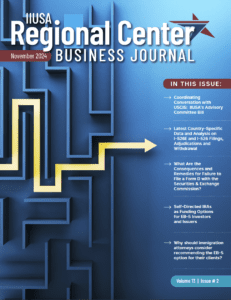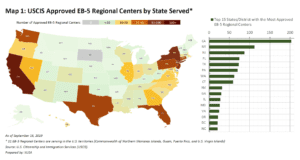Impact of the Emergence of Broker-Dealers in EB-5 on Escrow and Fund Administration by Regional Centers (Vol. 2, Issue 2, June 2014, Pgs. 26-27)
 If you are considering engaging a Broker-Dealer for your next project, be sure to set up your offering to be compliant for that option.
If you are considering engaging a Broker-Dealer for your next project, be sure to set up your offering to be compliant for that option.
Over the last year in EB-5, there has been a consistent drumbeat of increasing oversight from the SEC and USCIS to ensure compliance with regulations. This trend is good for the industry overall, and is leading toward the deployment in EB-5 of some best practices originally developed in support of more traditional investment funds.
At the quarterly EB-5 stakeholders meeting on April 3, 2013, and again at the May, 2014 IIUSA Advocacy Conference, the SEC division responsible for overseeing and enforcing US federal securities laws reaffirmed that US securities laws apply to EB-5 offerings. The traditional exemptions (Reg. D and Reg. S) used within the EB-5 industry are still valid, of course, and are used by most EB-5 Issuers. However, since the SEC has made clear its position on the topic, there has been an increasing trend toward the use of Broker-Dealers by EB-5 Issuers.
While Regional Centers are becoming much more aware of the compliance benefits of using Broker-Dealers, the rules that apply to Broker-Dealers and the ways they impact EB-5 projects are not well understood. These rules affect how offerings are structured, the banking relationships used, and how funds are escrowed and administered. Specifically, SEC Rules 10b-9 and15c2-4 have implications in these areas.
Broker-Dealers are subject to both FINRA and SEC rules. There are several categories of Broker-Dealers based upon the amount of net capital the SEC requires them to maintain. The type of Broker-Dealer that is most commonly involved in marketing Direct Participation Programs (“DPPs”) like EB-5 Regional Centers are those with a $5,000 net capital requirement. DPPs are generally sold in a “Best Efforts” offering, the form typically utilized in an EB-5 offering.
Rule 15c2-4 under the Securities Exchange Act of 1934 sets out the rules governing how investor funds are to be handled for “Best Efforts” offerings by Broker-Dealers. The rules for certain other “Best Efforts” issuances are described in Rule 10b-9.
When a Regional Center decides to use a Broker-Dealer, they will most likely use a DPP type who will require changes to the customary structure of a Regional Center offering as it relates to the collection of the marketing fees for the issuance of their interests as well as changes to their escrow arrangements.
Failure to comply with Rule 15c2-4 constitutes a “fraudulent, deceptive or manipulative act or practice” for the Broker-Dealers participating in the distribution of the RC’s subscription units. So, the Broker-Dealer will insist on compliance with this rule and on applying the suggestions found in Notice to Members (“NTM”) 84-64 and 87-61 published originally by the NASD (now known as FINRA) as guidelines for its Broker-Dealer members.
There are two parts of SEC Rule 15c2-4 that have a direct impact on EB-5 projects, in particular those offerings where the delivery of payment will not be made until a further event or contingency occurs (Rule 15c2-4(b)).
The first condition is that money received for the subscription of the interests must be deposited into a bank trust or escrow account with a written agreement that the bank will promptly either (a) transmit the funds to the appropriate people when the contingencies of the offering have been met, or (b) return the funds to the investors in the event the contingencies have not been met. Though not technically required by the Rule, custom and usage in the EB-5 industry has made it now typical that, mechanically, all subscription funds are made payable to the escrow agent (the bank) on behalf of or in connection with a particular EB-5 Issuer, and not directly to the Issuer or Broker-Dealer.
While the EB-5 Program itself has no requirement for an EB-5 Issuer to escrow funds, long-standing custom and usage in the EB-5 industry impels that investors’ funds be (and so they typically are) escrowed, although not necessarily with a bank as the escrow agent. Adding in Broker-Dealer involvement raises the bar by Rule 15c2-4’s requirement that escrow be used where delivery of funds will be contingent upon an event (such as USCIS adjudication), and more specifically in such cases, with a depository escrow agent that is a bank unaffiliated with the Issuer or the Broker-Dealer.
SEC Rule 10b-9, which applies to “any person, directly or indirectly” connected with the offering of or sale of a security, requires that in an offering where the securities are being offered on an “all or none” basis, or on the basis that a certain amount of securities must be sold (i.e., a minimum offering amount), then all of the consideration paid for a security must be promptly refunded to the purchaser if the specified number of interests is not sold at the specified price by the specified date.
Historically, we have seen the proceeds for interests in EB-5 projects divided into two separate amounts: (1) the price of the interest itself (usually $500,000) that will be deposited into an escrow account, and (2) an administration fee that may or may not be deposited into an escrow account. The administration fee is an additional cost to the investor that is usually paid to compensate the Issuer for expenses associated with marketing the project’s interests to foreign investors. If the capital raise does not reach the stated minimum amount (in an offering with such), or if the investor is denied by USCIS, the escrow agent will be required to return the $500,000 portion of the investors’ cost. However, the entire administrative fee may or may not be refunded, in whole or in part, as described in the offering memorandum.
Best Efforts offerings that include a Broker-Dealer will look different than this customary structure. When a Broker-Dealer participates in the capital raise for an EB-5 project, the cost of the interest will be “grossed up” to include both the real cost an investor will incur to acquire his interest and the administrative fee. The entire amount will be promptly deposited into the bank escrow account that was set up for the benefit of the investors. If the offering has a minimum or other condition, such as a specific closing date, and has successfully sold all or the minimum amount of the offering’s interests by the specified time, the bank will distribute the funds to the Issuer less the fee that will be paid as compensation to the Broker-Dealer (which will include sums received by the Broker-Dealer but to be paid to other agents). Otherwise, if the offering does not reach its minimum offering amount or its “all or none” requirement by the date specified in the offering, the entire amount will be returned to the investors. The bank also may not put a lien on the investor funds for payment of its fees before the minimum is met.
The second condition of SEC Rule 15c2-4 that must be met has to do with whether the receipt of funds is contingent, in which case the subscription amount must be promptly deposited in the bank escrow or trust account. It is also a “fraudulent, deceptive, or manipulative act or practice” for a Broker-Dealer participating in a “Best Efforts” distribution of securities to itself “accept any part of the sale price of any security being distributed” unless the money received is promptly deposited into an account like the one described above that was set up on behalf of the investors.
In view of the consequences to the Broker-Dealer for failure to comply with the provisions of SEC Rule 15c2-4, the Broker-Dealer will most certainly want to exercise control over or input as to the timing of investor deposits as well as the timing for the release of funds from the bank’s escrow account. FINRA has provided its members with guidelines on how to meet Rule 15c2-4’s “promptly deposit” requirement, and with sample escrow agreement language that will help the Broker-Dealer and the escrow agent comply with Rule 15c2-4.
FINRA NTM 84-64 provides acceptable procedures and time limits that will meet the requirements for prompt payment and prompt deposit. FINRA NTM 87-61 provides suggested Escrow Agreement Provisions for Members’ compliance with SEC Rule 15c2-4, which includes the underwriting Broker-Dealer as one of the parties to the escrow agreement.
The depository bank may invest escrowed funds in only very limited types of investments. Also, the bank may not invest funds in any type of investment whose maturity date is past the anticipated contingency occurrence date, unless the investments can readily be disposed of for cash by the time the contingency occurs. Such investment income may properly be paid to the Broker-Dealer, the Issuer, or the purchaser. Investor escrows are not required to pay interest to the investors while their funds were on deposit. However, where this is the case appropriate disclosure should be made in the offering document. FINRA will consider any interest paid to the Broker-Dealer as additional compensation.
These rules apply when a Broker-Dealer is being used in an offering. The SEC and FINRA implemented these rules for the protection of investors. Complying with these rules and protecting investors in EB-5 transactions is in the best interest of everyone in our industry. Whether the use of a Broker-Dealer is envisioned at the beginning of a project or not, care should be taken from the onset to avoid a structure that prohibits this flexibility in the future. Understanding the rules and their implications is the first step. ■
RCBJ Retrospective articles are reprinted from IIUSA’s Regional Center Business Journal trade magazine. Opinions expressed within these articles do not necessarily represent the views of IIUSA and are provided for educational purposes.







